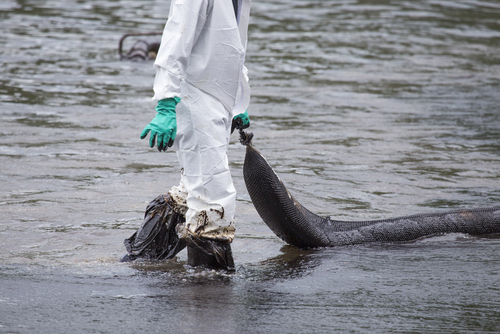 |
The Spill Prevention, Control, and Countermeasure (SPCC) Rule is intended primarily to protect waters of the United States from oil pollution in the event of a spill. Once a spill occurs, however, the speed of response and the use of appropriate containment and recovery equipment are key to avoiding long-term environmental and human health impacts.
On the front lines of oil spill control are floating containment booms, which should be used immediately to both prevent the oil from spreading and also keep it away from adjacent shorelines. Booms are available in many different designs but all have the following in common:
- Above-water freeboard that provides depth to contain the oil spill on the surface and protect that oil from wave action,
- A flotation device,
- Below-water skirt to both contain oil and help prevent loss of oil under the boom, and
- Longitudinal support, such as a chain or cable on the bottom of the skirt that helps to stabilize the boom in an upright position and strengthen it against the action of wind and waves.
Simplify SPCC compliance with the NEW TRAC360 platform. In just a few minutes, see how easy it is to create compliant plans and checklists, train your team, and find answers to all your SPCC questions. Learn More.
Typical types of booms include fence booms, round or curtain booms, and nonrigid inflatable booms, and each have their positive and negative features. For example, fence booms work better in calm water, round booms perform better in rough water but are more difficult to clean and store, and inflatable booms, while easy to clean and store are more expensive, complicated to use, and may puncture more easily. In the event that no manufactured booms are immediately available, booms can be improvised for temporary containment or diversion, especially in calm waters like streams, slow-moving rivers, and sheltered water bodies such as bays and inlets.
After an oil spill is contained, recovery can begin using skimmers and sorbents. Skimmers are used to recover oil from the surface of the water and are available in several types:
- Weir—Use a free-floating dam or enclosure positioned at the oil/water interface that allows floating oil to spill over and be trapped in a collecting sump and then pumped to storage.
- Oleophilic (oil attracting)—Use materials that “blot” the oil from the water’s surface as they are drawn or rotated through the slick. Oleophilic skimmers include:
- Discs that are best for lighter types of oil but cannot handle emulsified oil;
- Brushes and belts that are very effective but are large and require heavy equipment and trained personnel for deployment; and
- Vertical rope mops that are also large, require a crane, and are normally used for single sweep operations from a vessel or land.
- Vacuum—Use a wide, floating head like a vacuum cleaner to suck the oil from the surface into storage tanks and this is most effective on calm waters.
Sorbents are used to soak up oil using one of two mechanisms:
1) Absorption, which allows the oil to penetrate the pore spaces of the materials, or
2) Adsorption, which attracts the oil to their surface but does not allow it to penetrate the material’s pores.
The Ultimate SPCC Compliance Tool
TRAC360 for SPCC is a powerful application that simplifies compliance with EPA’s Spill Prevention, Control, and Countermeasure rule. Whether you need help creating your facility-specific SPCC plan, writing inspection checklists for your tanks, or training your oil-handling workforce, TRAC360 is there to help. Learn More.
For effective use in oil spills, sorbents must both attract oil and be water repellent and are most often used for small spills, in the final cleanup stages to recover the last traces of oil, or in areas where other means cannot be deployed. Sorbents are made of many different man-made and natural materials with different properties and capabilities so each should be assessed for the following characteristics:
- Rate of absorption based on the thickness of the oil since light oils are absorbed faster than heavy oils,
- Oil retention because the sheer weight of the absorbed oil can cause the sorbent to become deformed and release oil during removal from the water, and
- Ease of application, such as manually or using fans or blowers to apply natural organic sorbents like clay or vermiculite.
